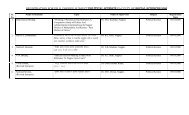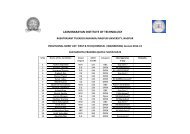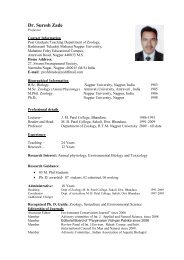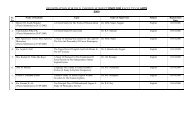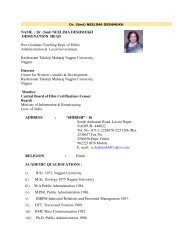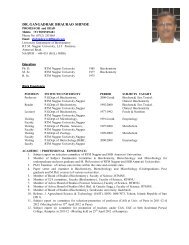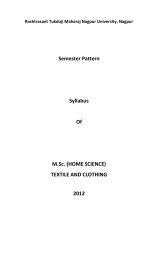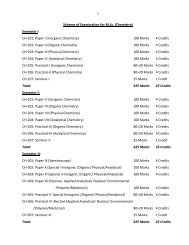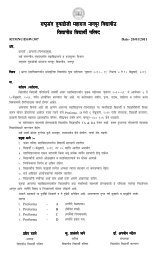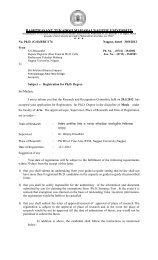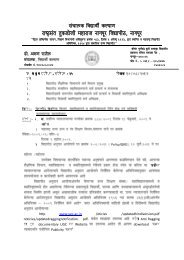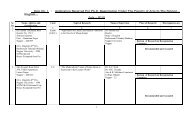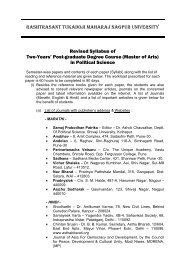Master of Pharmacy - Nagpur University
Master of Pharmacy - Nagpur University
Master of Pharmacy - Nagpur University
You also want an ePaper? Increase the reach of your titles
YUMPU automatically turns print PDFs into web optimized ePapers that Google loves.
Subject code: MC-S8<br />
Subject: BIOLOGICAL EVALUATION<br />
THEORY: 60 Hours (4 hrs. /week)<br />
1. Principles <strong>of</strong> Pharmacological and Pre-clinical Evaluation <strong>of</strong> drugs. Commonly used<br />
laboratory animals in pharmacological research, limitations <strong>of</strong> animal tests Standard<br />
techniques used in laboratory animals, euthanasia <strong>of</strong> experimental animals, Regulations for<br />
laboratory animal care and ethical requirements.<br />
2. Bioassays: Basic principles <strong>of</strong> bioassays, <strong>of</strong>ficial bioassays, experimental models, design<br />
<strong>of</strong> bioassays.<br />
3. Toxicology: Principles <strong>of</strong> toxicity evaluations. Safety evaluation <strong>of</strong> new drugs in animals<br />
including acute, sub-acute, sub chronic and chronic toxicity. ED50 and LD50 determination,<br />
special toxicity test like teratogenecity and mutagenecity. Various guidelines for toxicity<br />
studies. International guidelines and regulatory agencies for toxicity studies like ICH,<br />
OECD, FDA, WHO etc.<br />
4. Modern Methods <strong>of</strong> Pharmacological evaluations: Radioligand binding assay, patch<br />
clamp, stereotaxic technique and ELISA. Recent advances in transgenic and genetically<br />
modified animals for drug screening and other sophisticated methods<br />
5. Alternatives to animal screening procedures: Cell line - handling, maintenance and<br />
propagation <strong>of</strong> cell lines, their uses and limitations. In-vitro testing <strong>of</strong> drugs.<br />
6. Preclinical Evaluation: Preclinical models employed and organization <strong>of</strong> screening <strong>of</strong><br />
new drugs <strong>of</strong> following categories:<br />
i) Sedatives, hypnotics, anxiolytics, antidepressants, antipsychotics, nootropics,<br />
antiparkinsonian agents, analgesics, antipyretics.<br />
ii) Anti-inflammatory agents, anticonvulsants, local aneasthetics, CNS stimulants.<br />
iii) Cardiac glycosides, antiarrhythmic, antihypertensive, antianginal, anti-<br />
atherosclerotic,<br />
iv) Antiulcer agents, Laxatives, Bronchodilators, antitussives,<br />
v) Diuretics.<br />
vi) Histamine antagonists.<br />
vii) Muscle relaxants, Anticholinesterases, anticholinergics, adrenolytics.<br />
viii) Hypoglycemics, antifertility agents, androgens.<br />
ix) Anti-thyroid agents, Dermatological agents, Antitumor agents.<br />
x) Anthelmintics, Antimalarials, Antileprotics.<br />
xi) Drugs used for glaucoma, cataract and eye inflammation.<br />
RECOMMENDED BOOKS:<br />
1. Laurence D R and Bacharach A L, Evaluation <strong>of</strong> Drug Activities: Pharmacometrics,<br />
Academic Press, London & New York.<br />
2. Nodine J H and Siegler P E, Animal and Clinical Pharmacological Techniques in Drug<br />
3. Evaluation, Year Book Medical Publishers Chicago.<br />
4. Turner R A and Hebbron P, Screening Methods in Pharmacology, Vol I & II, Academic<br />
Press, New York, 2009.<br />
5. Vogel H G, Drug Discovery and Evaluation, Pharmacological Assays, Springer_verlog<br />
Berlin Heidelberg, 2007.<br />
25



